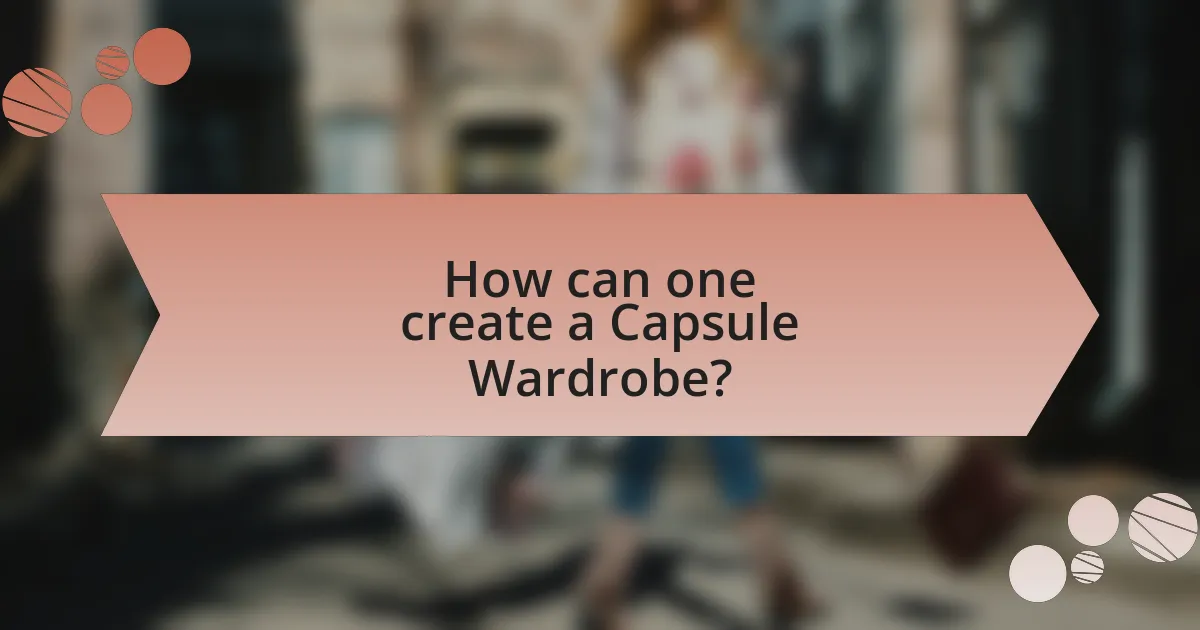A capsule wardrobe is a curated collection of 30 to 40 essential clothing items designed for versatility and sustainability, promoting minimalism by encouraging individuals to own fewer, high-quality pieces. This approach differs from traditional wardrobes by focusing on intentionality and reducing clothing waste, aligning with sustainable fashion principles. Key principles include minimalism, versatility, and intentionality, which enhance personal style while simplifying daily outfit choices. The article explores the benefits of adopting a capsule wardrobe, including reduced decision fatigue, financial savings, and a positive impact on consumer behavior, while providing practical tips for creating and maintaining an effective capsule wardrobe.

What is a Capsule Wardrobe?
A capsule wardrobe is a curated collection of essential clothing items that can be mixed and matched to create various outfits. This concept promotes minimalism and sustainability by encouraging individuals to own fewer, high-quality pieces that reflect their personal style. Research indicates that a typical capsule wardrobe consists of around 30 to 40 items, which can significantly reduce clothing waste and consumption, aligning with sustainable fashion principles.
How does a Capsule Wardrobe differ from a traditional wardrobe?
A capsule wardrobe differs from a traditional wardrobe primarily in its size and focus on versatility. A capsule wardrobe typically consists of a limited number of essential, high-quality pieces that can be mixed and matched to create various outfits, often ranging from 30 to 40 items. In contrast, a traditional wardrobe usually contains a larger collection of clothing, often including many items that may not be frequently worn. This streamlined approach in capsule wardrobes promotes sustainability by encouraging mindful consumption and reducing waste, as supported by the minimalist fashion movement which emphasizes quality over quantity.
What are the key principles of a Capsule Wardrobe?
The key principles of a Capsule Wardrobe include minimalism, versatility, and intentionality. Minimalism focuses on reducing the number of clothing items to a curated selection, typically ranging from 30 to 50 pieces, which simplifies choices and reduces clutter. Versatility emphasizes selecting items that can be mixed and matched to create various outfits, maximizing the use of each piece. Intentionality involves making thoughtful purchases based on personal style and needs, ensuring that each item serves a purpose and aligns with the individual’s lifestyle. These principles promote sustainable fashion by encouraging mindful consumption and reducing waste.
How many pieces are typically included in a Capsule Wardrobe?
A typical capsule wardrobe includes around 30 to 40 pieces. This range allows for a versatile selection of clothing that can be mixed and matched, promoting a minimalist approach to fashion. The concept of a capsule wardrobe emphasizes quality over quantity, encouraging individuals to curate a collection that reflects their personal style while minimizing clutter.
Why is a Capsule Wardrobe considered a minimalist approach?
A capsule wardrobe is considered a minimalist approach because it emphasizes a limited selection of versatile clothing items that can be mixed and matched, reducing clutter and decision fatigue. This strategy aligns with minimalist principles by promoting simplicity and intentionality in fashion choices, allowing individuals to focus on quality over quantity. Research indicates that adopting a capsule wardrobe can lead to a more sustainable lifestyle, as it encourages mindful consumption and reduces the environmental impact associated with fast fashion.
What are the benefits of minimalism in fashion?
Minimalism in fashion offers several benefits, including reduced clutter, cost savings, and enhanced personal style. By focusing on a limited number of versatile pieces, individuals can simplify their wardrobe, making it easier to choose outfits and reducing decision fatigue. This approach not only saves time but also encourages thoughtful purchasing, leading to fewer impulse buys and ultimately lower spending. Additionally, minimalism promotes sustainability by encouraging the use of high-quality, timeless items that last longer, thereby reducing waste in the fashion industry. Studies indicate that consumers who adopt minimalist wardrobes often report higher satisfaction with their clothing choices, as they can express their personal style more clearly through curated selections.
How does minimalism contribute to sustainability?
Minimalism contributes to sustainability by promoting the reduction of consumption and waste, which directly decreases environmental impact. By focusing on fewer, high-quality items, individuals minimize the resources used in production, transportation, and disposal. For instance, a study published in the Journal of Cleaner Production found that reducing clothing consumption by 50% can lead to a significant decrease in carbon emissions, water usage, and waste generation. This approach aligns with sustainable practices by encouraging mindful purchasing and extending the lifecycle of products, ultimately fostering a more sustainable fashion industry.
What role does a Capsule Wardrobe play in sustainable fashion?
A Capsule Wardrobe plays a crucial role in sustainable fashion by promoting minimalism and reducing clothing consumption. This approach encourages individuals to curate a limited selection of versatile, high-quality garments that can be mixed and matched, thereby minimizing the need for excessive purchases. Research indicates that the fashion industry is responsible for approximately 10% of global carbon emissions, and adopting a Capsule Wardrobe can significantly lower one’s environmental footprint by extending the lifespan of clothing and reducing waste. By focusing on quality over quantity, a Capsule Wardrobe supports sustainable practices and fosters a more conscious consumer mindset.
How does a Capsule Wardrobe reduce waste in the fashion industry?
A Capsule Wardrobe reduces waste in the fashion industry by promoting a limited selection of versatile clothing items that can be mixed and matched, thereby decreasing the frequency of new purchases. This approach minimizes overconsumption, which is a significant contributor to textile waste; according to the Environmental Protection Agency, in 2018, 11.3 million tons of textile waste were generated in the U.S. alone. By encouraging consumers to invest in quality over quantity, Capsule Wardrobes help extend the lifecycle of garments, ultimately leading to less waste and a more sustainable fashion ecosystem.
What impact does a Capsule Wardrobe have on consumer behavior?
A Capsule Wardrobe significantly influences consumer behavior by promoting mindful purchasing and reducing impulsive buying. This approach encourages individuals to curate a limited selection of versatile clothing items, which leads to a more intentional shopping experience. Research indicates that consumers who adopt a Capsule Wardrobe often report decreased clothing purchases, with studies showing a reduction in wardrobe size by up to 50% and a corresponding increase in satisfaction with their clothing choices. This shift not only fosters a more sustainable fashion mindset but also aligns with growing consumer trends towards minimalism and environmental consciousness.

How can one create a Capsule Wardrobe?
To create a capsule wardrobe, one should select a limited number of versatile clothing pieces that can be mixed and matched to create various outfits. This process typically involves evaluating personal style, identifying essential items, and choosing a cohesive color palette. Research indicates that a capsule wardrobe usually consists of 30 to 40 pieces, including tops, bottoms, outerwear, and shoes, which allows for a streamlined and efficient approach to dressing while minimizing clutter. By focusing on quality over quantity, individuals can enhance sustainability in fashion, as fewer items lead to reduced consumption and waste.
What steps are involved in building a Capsule Wardrobe?
Building a Capsule Wardrobe involves several key steps: first, assess your current wardrobe to identify items you wear frequently and those you don’t. Next, define your personal style by considering your lifestyle, preferences, and the occasions you dress for. After that, select a limited number of versatile pieces that can be mixed and matched, typically around 30 to 40 items, including tops, bottoms, outerwear, and shoes. Then, focus on quality over quantity by choosing durable materials that will last. Finally, maintain your Capsule Wardrobe by regularly reviewing and updating it to reflect changes in your style or needs. This structured approach promotes a minimalist and sustainable fashion practice.
How do you select versatile pieces for a Capsule Wardrobe?
To select versatile pieces for a Capsule Wardrobe, prioritize items that can be mixed and matched easily and serve multiple occasions. Focus on neutral colors and classic styles, as these enhance compatibility with various outfits. For instance, a well-fitted white shirt, a pair of tailored black trousers, and a versatile denim jacket can be combined in numerous ways, allowing for diverse looks. Research indicates that a Capsule Wardrobe typically consists of around 30-40 pieces, emphasizing quality over quantity, which supports sustainability by reducing the need for frequent purchases.
What criteria should be used to evaluate clothing for a Capsule Wardrobe?
To evaluate clothing for a Capsule Wardrobe, the criteria should include versatility, quality, fit, and personal style. Versatility ensures that each piece can be styled in multiple ways, maximizing outfit combinations. Quality refers to the durability and craftsmanship of the clothing, which is essential for longevity and sustainability. Fit is crucial, as well-fitting garments enhance comfort and appearance, making them more likely to be worn regularly. Personal style reflects individual preferences, ensuring that the selected pieces resonate with the wearer’s aesthetic, which promotes satisfaction and reduces the likelihood of items being discarded. These criteria collectively support the principles of a Capsule Wardrobe by emphasizing minimalism and intentionality in fashion choices.
What common mistakes should be avoided when creating a Capsule Wardrobe?
Common mistakes to avoid when creating a Capsule Wardrobe include failing to define personal style, which can lead to purchasing items that do not align with individual preferences. Additionally, neglecting to consider lifestyle needs can result in a wardrobe that lacks versatility and practicality. Overlooking quality in favor of quantity often leads to the inclusion of low-quality items that do not last, undermining the sustainability aspect of a Capsule Wardrobe. Lastly, not regularly reassessing and updating the wardrobe can cause it to become stagnant and less functional over time. These mistakes hinder the effectiveness of a Capsule Wardrobe in promoting a minimalist and sustainable fashion approach.
How can overcomplicating choices hinder the Capsule Wardrobe concept?
Overcomplicating choices can hinder the Capsule Wardrobe concept by creating decision fatigue, which undermines the simplicity and efficiency that the concept aims to provide. When individuals face too many options, they may struggle to make quick and confident decisions about what to wear, leading to frustration and a return to a cluttered wardrobe. Research indicates that having fewer choices can enhance satisfaction and reduce anxiety, as demonstrated in studies by Iyengar and Lepper (2000), which found that participants offered fewer options were more likely to make a choice and report greater satisfaction with their decision. Thus, excessive complexity in clothing options contradicts the fundamental principle of a Capsule Wardrobe, which is to streamline choices for a more sustainable and manageable fashion experience.
What are the pitfalls of not considering personal style in a Capsule Wardrobe?
Not considering personal style in a Capsule Wardrobe can lead to a lack of satisfaction and reduced wearability of the clothing. When individuals do not align their wardrobe choices with their personal aesthetic, they may find themselves with pieces that do not resonate with their identity, resulting in frustration and a tendency to revert to old, less sustainable habits. Research indicates that personal style significantly influences clothing choices and overall happiness with one’s wardrobe, as noted in a study published in the Journal of Fashion Marketing and Management, which highlights the importance of personal expression in fashion. Therefore, neglecting personal style can undermine the effectiveness of a Capsule Wardrobe, making it less functional and enjoyable.

What are the benefits of adopting a Capsule Wardrobe?
Adopting a Capsule Wardrobe offers several benefits, including reduced decision fatigue, increased sustainability, and enhanced personal style. By limiting clothing choices to a select number of versatile pieces, individuals experience less stress when selecting outfits, which streamlines daily routines. This approach also promotes sustainability, as it encourages mindful consumption and reduces waste, aligning with eco-friendly practices. Furthermore, a Capsule Wardrobe allows individuals to cultivate a distinct personal style, as the focus on quality over quantity leads to more intentional fashion choices. Studies indicate that minimalist wardrobes can lead to greater satisfaction with clothing choices and a more organized lifestyle.
How does a Capsule Wardrobe simplify daily life?
A capsule wardrobe simplifies daily life by reducing decision fatigue and streamlining outfit choices. With a limited selection of versatile clothing items, individuals can easily mix and match pieces, leading to quicker dressing times and less stress over what to wear. Research indicates that simplifying choices can enhance mental clarity and productivity, as seen in studies showing that fewer options lead to better decision-making outcomes. By focusing on quality over quantity, a capsule wardrobe also promotes sustainable fashion practices, encouraging mindful consumption and reducing clutter in living spaces.
What time-saving advantages does a Capsule Wardrobe provide?
A Capsule Wardrobe provides significant time-saving advantages by simplifying daily outfit choices and reducing decision fatigue. With a limited selection of versatile clothing items, individuals can quickly assemble outfits without extensive deliberation. Research indicates that people spend an average of 17 minutes daily deciding what to wear, which can be drastically reduced with a streamlined wardrobe. This efficiency not only saves time but also enhances productivity, allowing individuals to focus on more important tasks throughout their day.
How can a Capsule Wardrobe enhance personal style?
A Capsule Wardrobe enhances personal style by providing a curated selection of versatile clothing items that can be mixed and matched, allowing for greater creativity and expression in daily outfits. This intentional approach simplifies decision-making, reduces clutter, and encourages individuals to focus on quality over quantity, which can lead to a more cohesive and authentic personal style. Studies show that individuals with a Capsule Wardrobe often report increased satisfaction with their clothing choices, as they can easily create outfits that reflect their personality and preferences without the overwhelm of excessive options.
What financial benefits can be gained from a Capsule Wardrobe?
A Capsule Wardrobe can lead to significant financial benefits by reducing clothing expenses and minimizing impulse purchases. By focusing on a limited selection of versatile, high-quality pieces, individuals can avoid the costs associated with fast fashion, which averages $1,200 annually per person in the U.S. According to a study by the Ellen MacArthur Foundation, the fashion industry generates $500 billion in waste each year, highlighting the financial inefficiency of excessive clothing consumption. Additionally, a Capsule Wardrobe encourages thoughtful purchasing, leading to fewer but more meaningful investments in clothing, ultimately saving money over time.
How does investing in quality over quantity save money in the long run?
Investing in quality over quantity saves money in the long run by reducing the frequency of replacements and minimizing maintenance costs. High-quality items typically last longer and withstand wear and tear better than cheaper alternatives, leading to fewer purchases over time. For example, a well-made coat may cost more upfront but can last a decade, while a cheaper coat might need replacement every couple of years. This longevity translates into lower overall spending on clothing. Additionally, quality items often retain their value better, allowing for potential resale opportunities, further offsetting costs.
What are the cost implications of maintaining a Capsule Wardrobe?
Maintaining a Capsule Wardrobe typically results in lower overall clothing costs due to its focus on quality over quantity. By investing in a limited number of versatile, high-quality pieces, individuals can reduce the frequency of purchases and avoid fast fashion expenses. Research indicates that consumers can save an average of 30% on clothing expenses by adopting a Capsule Wardrobe approach, as it encourages thoughtful purchasing and minimizes impulse buys. This strategy not only leads to financial savings but also promotes sustainable fashion practices by reducing waste and the environmental impact associated with clothing production.
What practical tips can help in maintaining a Capsule Wardrobe?
To maintain a Capsule Wardrobe effectively, regularly assess and curate your clothing collection by removing items that no longer fit your style or needs. This practice ensures that your wardrobe remains functional and aligned with your lifestyle. Additionally, organizing your clothes by category and color can enhance visibility and accessibility, making it easier to mix and match outfits. Implementing a one-in, one-out rule when acquiring new pieces helps to prevent clutter and maintain the desired number of items. Research indicates that a well-maintained Capsule Wardrobe can lead to reduced decision fatigue and increased satisfaction with clothing choices, supporting a minimalist approach to sustainable fashion.
How often should you reassess your Capsule Wardrobe?
You should reassess your Capsule Wardrobe at least twice a year. This frequency allows you to evaluate your clothing choices in relation to seasonal changes, personal style evolution, and lifestyle shifts. Research indicates that regular reassessment helps maintain a functional and cohesive wardrobe, ensuring that each piece aligns with your current needs and preferences.
What strategies can be employed to keep a Capsule Wardrobe fresh and relevant?
To keep a Capsule Wardrobe fresh and relevant, regularly assess and rotate items based on seasonal trends and personal style changes. This involves evaluating the current wardrobe every few months, removing pieces that are no longer worn or do not fit, and introducing a few new items that align with current fashion trends or personal preferences. Research indicates that a well-maintained Capsule Wardrobe can enhance sustainability by reducing waste and promoting mindful consumption, as it encourages individuals to invest in quality over quantity. Additionally, incorporating versatile pieces that can be styled in multiple ways ensures that the wardrobe remains dynamic and adaptable to various occasions.
